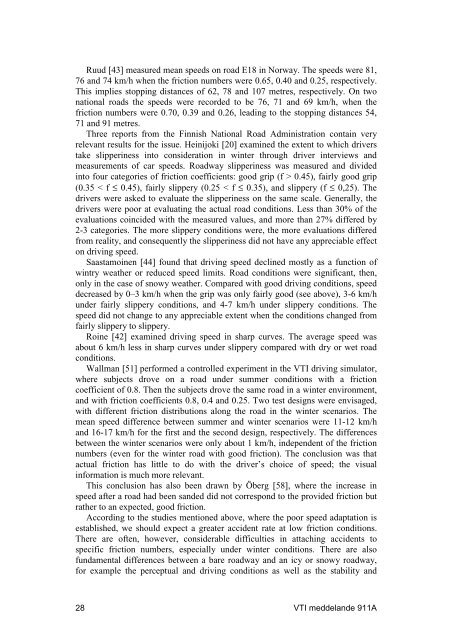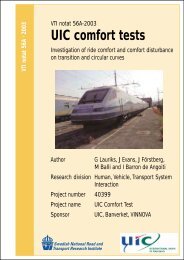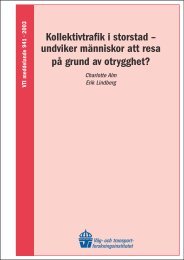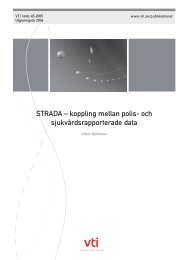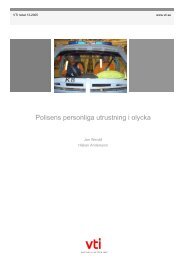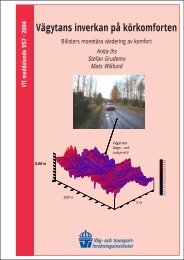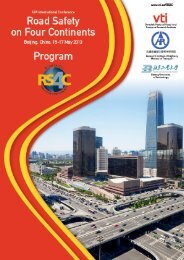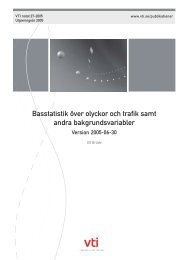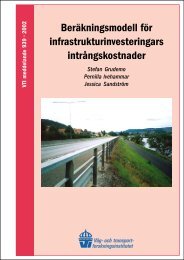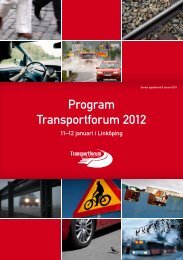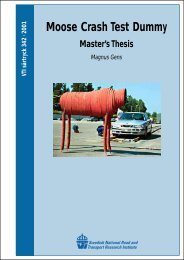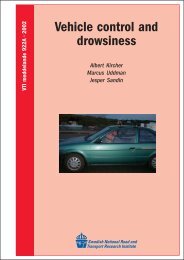Friction measurement methods and the correlation between road - VTI
Friction measurement methods and the correlation between road - VTI
Friction measurement methods and the correlation between road - VTI
Create successful ePaper yourself
Turn your PDF publications into a flip-book with our unique Google optimized e-Paper software.
Ruud [43] measured mean speeds on <strong>road</strong> E18 in Norway. The speeds were 81,76 <strong>and</strong> 74 km/h when <strong>the</strong> friction numbers were 0.65, 0.40 <strong>and</strong> 0.25, respectively.This implies stopping distances of 62, 78 <strong>and</strong> 107 metres, respectively. On twonational <strong>road</strong>s <strong>the</strong> speeds were recorded to be 76, 71 <strong>and</strong> 69 km/h, when <strong>the</strong>friction numbers were 0.70, 0.39 <strong>and</strong> 0.26, leading to <strong>the</strong> stopping distances 54,71 <strong>and</strong> 91 metres.Three reports from <strong>the</strong> Finnish National Road Administration contain veryrelevant results for <strong>the</strong> issue. Heinijoki [20] examined <strong>the</strong> extent to which driverstake slipperiness into consideration in winter through driver interviews <strong>and</strong><strong>measurement</strong>s of car speeds. Roadway slipperiness was measured <strong>and</strong> dividedinto four categories of friction coefficients: good grip (f > 0.45), fairly good grip(0.35 < f ≤ 0.45), fairly slippery (0.25 < f ≤ 0.35), <strong>and</strong> slippery (f ≤ 0,25). Thedrivers were asked to evaluate <strong>the</strong> slipperiness on <strong>the</strong> same scale. Generally, <strong>the</strong>drivers were poor at evaluating <strong>the</strong> actual <strong>road</strong> conditions. Less than 30% of <strong>the</strong>evaluations coincided with <strong>the</strong> measured values, <strong>and</strong> more than 27% differed by2-3 categories. The more slippery conditions were, <strong>the</strong> more evaluations differedfrom reality, <strong>and</strong> consequently <strong>the</strong> slipperiness did not have any appreciable effecton driving speed.Saastamoinen [44] found that driving speed declined mostly as a function ofwintry wea<strong>the</strong>r or reduced speed limits. Road conditions were significant, <strong>the</strong>n,only in <strong>the</strong> case of snowy wea<strong>the</strong>r. Compared with good driving conditions, speeddecreased by 0–3 km/h when <strong>the</strong> grip was only fairly good (see above), 3-6 km/hunder fairly slippery conditions, <strong>and</strong> 4-7 km/h under slippery conditions. Thespeed did not change to any appreciable extent when <strong>the</strong> conditions changed fromfairly slippery to slippery.Roine [42] examined driving speed in sharp curves. The average speed wasabout 6 km/h less in sharp curves under slippery compared with dry or wet <strong>road</strong>conditions.Wallman [51] performed a controlled experiment in <strong>the</strong> <strong>VTI</strong> driving simulator,where subjects drove on a <strong>road</strong> under summer conditions with a frictioncoefficient of 0.8. Then <strong>the</strong> subjects drove <strong>the</strong> same <strong>road</strong> in a winter environment,<strong>and</strong> with friction coefficients 0.8, 0.4 <strong>and</strong> 0.25. Two test designs were envisaged,with different friction distributions along <strong>the</strong> <strong>road</strong> in <strong>the</strong> winter scenarios. Themean speed difference <strong>between</strong> summer <strong>and</strong> winter scenarios were 11-12 km/h<strong>and</strong> 16-17 km/h for <strong>the</strong> first <strong>and</strong> <strong>the</strong> second design, respectively. The differences<strong>between</strong> <strong>the</strong> winter scenarios were only about 1 km/h, independent of <strong>the</strong> frictionnumbers (even for <strong>the</strong> winter <strong>road</strong> with good friction). The conclusion was thatactual friction has little to do with <strong>the</strong> driver’s choice of speed; <strong>the</strong> visualinformation is much more relevant.This conclusion has also been drawn by Öberg [58], where <strong>the</strong> increase inspeed after a <strong>road</strong> had been s<strong>and</strong>ed did not correspond to <strong>the</strong> provided friction butra<strong>the</strong>r to an expected, good friction.According to <strong>the</strong> studies mentioned above, where <strong>the</strong> poor speed adaptation isestablished, we should expect a greater accident rate at low friction conditions.There are often, however, considerable difficulties in attaching accidents tospecific friction numbers, especially under winter conditions. There are alsofundamental differences <strong>between</strong> a bare <strong>road</strong>way <strong>and</strong> an icy or snowy <strong>road</strong>way,for example <strong>the</strong> perceptual <strong>and</strong> driving conditions as well as <strong>the</strong> stability <strong>and</strong>28 <strong>VTI</strong> meddel<strong>and</strong>e 911A


